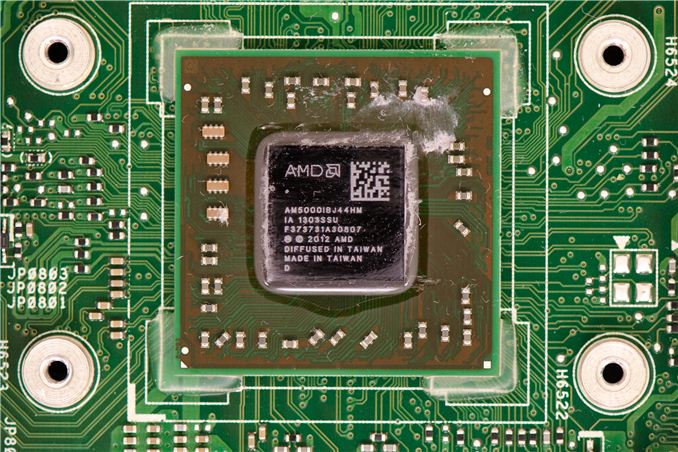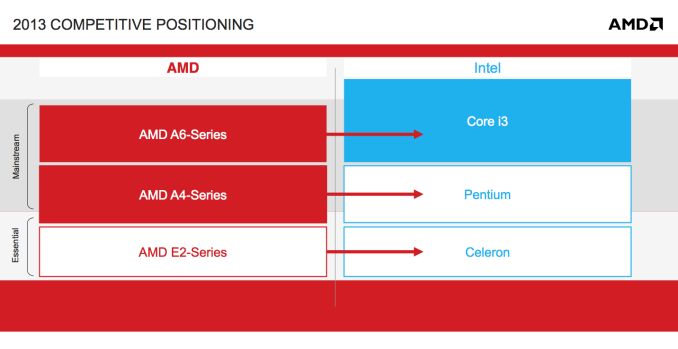The Kabini Deal: Can AMD Improve the Quality of Mainstream PCs with Its Latest APU?
by Anand Lal Shimpi on May 24, 2013 1:45 PM EST
There are two non-negotiables in building a PC these days: the cost of Intel silicon and the cost of the Windows license. You can play with everything else but Intel and Microsoft are going to get their share. Those two relatively fixed costs in the PC bill of materials can do one of two things: encourage OEMs to skimp on component cost elsewhere, or drive the entire ecosystem to supply higher quality components at lower prices. If you’ve been following the PC industry for the past decade, I think we’ve seen more of the former and less of the latter.
Apple occupying the high-end of the notebook PC space has forced many OEMs to reconsider their approach, but that’s a more recent change. What AMD seems to offer is an easier path. AMD will take less of the BoM, allowing OEMs to invest those savings elsewhere - a move Intel will never make. Given how much pressure the PC OEMs have been under for the past few years, AMD’s bargain is more appealing now than it has ever been.
With Llano and Trinity, AMD’s story was about giving up CPU performance for GPU performance. With Kabini, the deal is more palatable. You only give up CPU performance compared to higher priced parts (you gain performance compared to Atom), and you get much lower power silicon that can run in thinner/lighter notebooks. Typically at the price points Kabini is targeting (sub-$400 notebooks), you don’t get pretty form factors with amazing battery life. AMD hopes to change that.
While AMD hasn’t disclosed OEM pricing on Kabini (similarly, Intel doesn’t list OEM pricing on its mobile Pentium SKUs), it’s safe to assume that AMD will sell Kabini for less than Intel will sell its competing SKUs. If Kabini’s die size is indeed around 107mm^2, that puts it in the same range as a dual-core Ivy Bridge. AMD can likely undercut Intel a bit and live off of lower margins, but there’s one more component to think about: Ivy Bridge needs its PCH (Platform Controller Hub), Kabini does not. As a more fully integrated SoC, Kabini’s IO duties are handled by an on-die Fusion Controller Hub. Intel typically charges low double digits for its entry level chipsets, which is money AMD either rolls into the cost of Kabini or uses as a way of delivering a lower total cost to OEMs.
Traditionally, OEMs would take these cost savings and pass them along to the end user. I get the impression that AMD’s hope with Kabini is for OEMs to instead take the cost savings and redeploy them elsewhere in the system. Perhaps putting it towards a small amount of NAND on-board for a better user experience, or maybe towards a better LCD.
As we found in yesterday’s article, Kabini does a great job against Atom and Brazos. However, even with double digit increases in performance, Kabini is still a little core and no match for the bigger Ivy Bridge parts. Much to our disappointment, we pretty much never get sent low end hardware for review - so to make yesterday’s NDA we had to stick with 17W Ivy Bridge and extrapolate performance from there. In the past day I grabbed an ASUS X501A system, a 15-inch entry-level machine priced in the low $300s. More importantly, it features a 35W Ivy Bridge based Pentium CPU: the dual-core 2020M.
The Pentium 2020M’s base clock speed is still relatively high at 2.4GHz, but there’s no turbo. In the low level CPU performance analysis yesterday I used a Surface Pro with a 17W 1.7GHz Core i5, but max turbo on that part can hit 2.6GHz. I actually don’t expect there to be huge CPU performance differences between the results from yesterday and what I have here but I wanted to be sure.
The bigger difference is actually on the GPU side. While a mobile Core i5 comes with Intel’s HD 4000 graphics, the Pentium 2020M gets a vanilla Intel HD GPU. At 22nm, Intel’s HD graphics is a 6 EU part with lower performance than the previous generation Intel HD 3000.
With that said, let’s see how Kabini (AMD’s A4-5000 in particular) compares to an Ivy Bridge based Pentium 2020M in CPU performance, GPU performance and finally in power.











108 Comments
View All Comments
chizow - Friday, May 24, 2013 - link
I don't understand what the market is for one of these. Pretty poor CPU performance and untenable graphics performance for anything more than video streaming/web surfing. Seems to me like a faster CPU with less emphasis on GPU (i3-3XXX) paired with a low-power, low-profile discrete GPU would be the better way to go.jeffkibuule - Friday, May 24, 2013 - link
Uhh... these are going into $300 laptops. There will be no discrete GPUs here.Frenetic Pony - Friday, May 24, 2013 - link
This is really the market here. I'm fine with my 17 watt Ivy Core i5 Ivy bridge thanks, and my sister will be good with a 15 watt Haswell when she gets a new laptop next month. The key here is price, not performance per watt, in which case you'd just go with a Core i-whatever (possibly with a dedicated Nvidia GPU) and call it good.medi02 - Tuesday, May 28, 2013 - link
So what kind of apps does our sister run, to justify need for a faster performing CPU? (and doh, just i5 won't cut it, you need a ULW part, or you are losing on longevity vs Kabini; So we are talking what, twice or triple the price?)chizow - Friday, May 24, 2013 - link
I see, so these are like Netbook 2.0, I figured it was the first step to making AMD's Fusion a huge success with the APU, offering much faster graphics than ever before on a CPU. But it's really AMD's version of the Atom?Gigaplex - Saturday, May 25, 2013 - link
AMD has two main Fusion lines. This line is the Atom competitor, which uses the low power CPU architecture (Bobcat derivative). The APUs that offer the high end graphics use the higher performance architecture (Bulldozer derivative). It sounds like you'd be more interested in the upcoming Kaveri chips.Voldenuit - Sunday, May 26, 2013 - link
I'm with chizow. AMD is trying to sell a sub-par device upmarket. These things really belonged in netbooks from 2 years ago. Their performance and and pricepoint is irrelvant today when a $200-300 Android tablet is a better ancillary computing device than a $300-400 netbook.The tablet may have less computing power and not be able to run the full suite of x86 productivity software, but will have a better screen, better battery life, more portability, and more importantly, said tablet would be better suited to running its native lightweight Android apps and games than Kabini, which is burdened with full-fat x86 programs targeted at more powerful CPUs/GPUs.
glsunder - Sunday, May 26, 2013 - link
If you're not gaming, this would be quite nice for a little laptop. Most laptops with these apus won't have dvd drives, so they won't be used for ripping. If I'm going to play a game, it'll be on my desktop.I have an e-350 based laptop that I bought a few years ago. Under windows, it was plenty fast enough to do coding on and run VMs (vs no VM on atom). It was too slow to run an android ARM emulator, but native x86 android worked fine for testing apps. I recently switched it to Ubuntu, which is quite a bit more responsive than Win7.
hyperspaced - Monday, May 27, 2013 - link
"Full-fat x86 programs"? Are you talking about the CISC-RISC age-old comparison?So, what's your point? The same software will run better on RISC architecture?
Voldenuit - Monday, May 27, 2013 - link
The point is that most apps on Android are simpler and less resource-intensive because they are designed for:a. lower power CPUs
b. lower feature set
You can do more with most windows program suites than the comparable alternatives on Android, but if you want to do anything beyond basic editing/viewing, you'd be better off with a Corei/Richland laptop anyway.